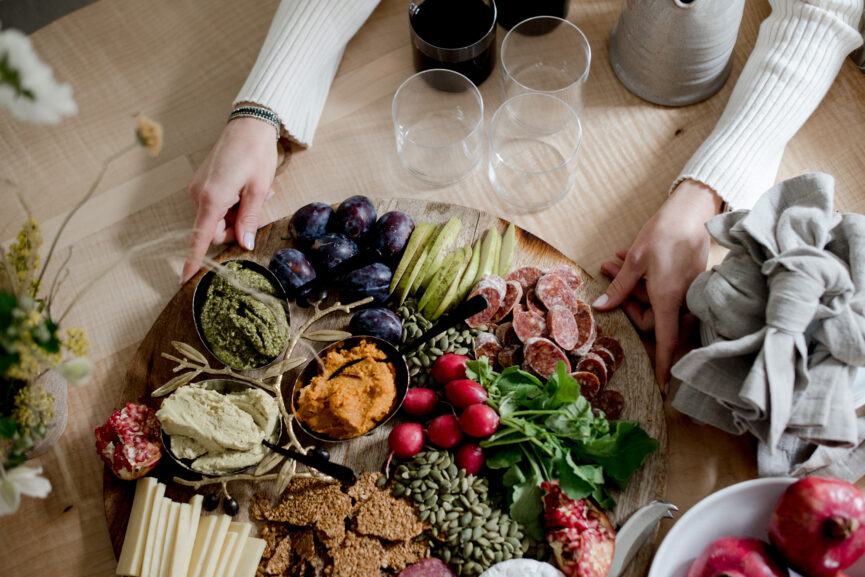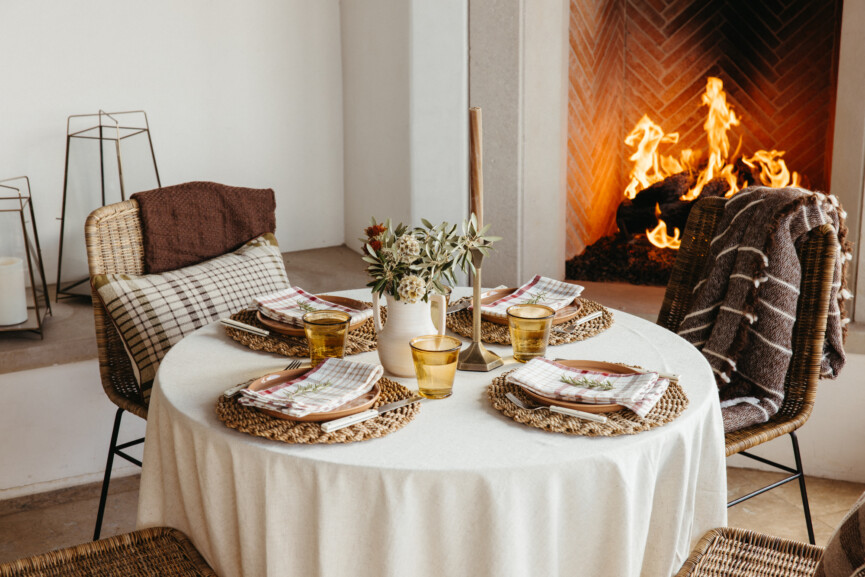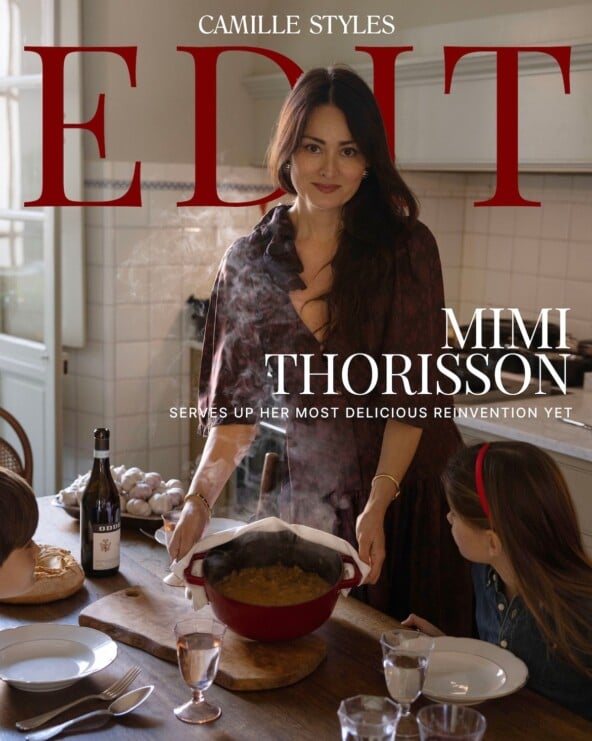
Photos by Michelle Nash
Somewhere along the way, gatherings became another form of perfectionism. Menus planned down to the garnish, tables styled to impress, hosts too busy to enjoy their own party. The soft host rejects that script. She sets the table for connection, not control—reminding us that hospitality begins long before anyone takes a seat.
This is your invitation to do the same. To host with ease, with less pressure and more presence. To trade performance for participation and rediscover the simple joy of bringing people together. Because the best kind of beauty isn’t styled—it’s felt.
What It Means to Be a Soft Host
To host softly is to lead with warmth, not worry. It’s about creating space that feels alive—where conversation unfolds naturally and the beauty lies not in performance, but in presence. The soft host believes that ease isn’t the absence of effort; it’s the result of intention.
This manifesto is for her—for anyone craving a slower, truer kind of hospitality. It’s about intention over excess, beauty that breathes, and moments that feel as good as they look. From the menu to the mood to the final candle flicker, these are the new rules of hosting: gentler, freer, and infinitely more joyful.

The New Rules of Gathering
Because the best gatherings don’t leave you exhausted—they leave you restored. They invite laughter that lingers, warmth that fills the air, and a sense that everyone (including you) got exactly what they needed.
These days, the dinners that stay with us aren’t the ones styled to perfection—they’re the ones that make us feel something. This is your permission to host differently: with ease, generosity, and softness at the center.
Rule 1: Start With How You Want It to Feel
Before you plan a single dish or think about the table, ask yourself one question: how do I want this gathering to feel? (For more inspiration, explore our favorite dinner party hosting lessons from hosts who make it look effortless.)
The soft host begins with mood, not menu. Maybe it’s unhurried and intimate, or maybe it’s spontaneous and full of laughter, with friends dropping by for a pot of soup. Once you decide the feeling, every detail can follow: the playlist, the lighting, the way you greet your guests at the door.
When your intention leads, the rest falls into place naturally. The food doesn’t have to be perfect (honestly, the napkins don’t even have to match). What people will remember is the way the room felt—the sense that they were welcomed exactly as they are.
The Soft Host’s Takeaway
- Lead with emotion, not expectation. Choose a feeling before you choose a theme.
- Let intention guide the details. Every sensory cue—from scent to sound—can reinforce how you want guests to feel.
- Presence over polish. A relaxed host sets the tone for a relaxed room.
Rule 2: Redefine Effort
Hosting well isn’t about how much you do—it’s about where you choose to give your energy. There’s quiet skill in knowing when to pour yourself into the details and when to let them go. The soft host learns this balance over time: that a simple tossed salad, a playlist that fits the room, and a seat at the table are often enough.
Think of effort not as intensity, but as attention. Lighting a candle before guests arrive, remembering someone’s favorite drink, clearing the plates without making a production of it—these gestures speak louder than anything performative. They remind guests that you’re not just hosting them; you’re with them.
Because when your effort shifts from impressing to connecting, everything changes. You stop chasing applause and start cultivating ease—the kind that makes everyone breathe a little deeper.
The Soft Host’s Takeaway
- Be intentional with your energy. Effort matters most when it feels aligned, not obligatory.
- Presence is the ultimate luxury. Be part of the moment, not managing it.
- Lead with attention, not ambition. Guests remember how you made them feel, not how much you did.
Rule 3: Let the Table Breathe
The most beautiful tables aren’t the most styled—they’re the ones that invite you in. A table that feels alive tells its own story: linen that’s a little undone, candlelight flickering against glass, a sprig of greenery bending just slightly out of place. It’s not about achieving balance—it’s about allowing space.
When every inch of a table is filled, there’s nowhere for the eye—or the guest—to rest. The soft host knows that restraint is its own kind of abundance. You don’t need an elaborate centerpiece or matching place settings to create beauty. You just need intention—a few well-chosen elements that speak to the season: woven textures, natural tones, and candlelight that moves with the air.
Leave room for the unexpected—the wine bottle placed mid-table, bread torn by hand, the small messes that make people feel at home. When the table breathes, so do the people around it. For step-by-step inspiration, see our guide to setting a table or learn how to style napkins with ease.
The Soft Host’s Takeaway
- Edit with feeling. A table isn’t a display—it’s a conversation.
- Prioritize texture over perfection. Linen, rattan, flickering light—let warmth lead the design.
- Leave space for life. The most inviting tables make room for movement, mess, and joy.
Rule 4: Cook One Thing Well
Every host has something that feels like second nature—the dish that never fails. The soft host leans into that. Instead of stretching yourself thin across a dozen recipes, choose one thing to make with care. Let it anchor the table.
Cooking shouldn’t feel like a performance—it’s an act of generosity. When you focus your energy on one beautiful dish, the process slows down. You notice the scent of garlic softening in olive oil, the warmth of the oven, the rhythm of stirring and tasting. This kind of cooking brings you back to presence—to the joy of creating something simple and deeply satisfying.
The rest can be store-bought, shared, or improvised. Salad from a friend, bread from the bakery, dessert from the freezer aisle. For more inspiration, explore our dinner party menu ideas and a few tried-and-true dinner party secrets that make entertaining feel effortless.
The beauty of the soft host’s kitchen is that it’s not about impressing—it’s about welcoming.
The Soft Host’s Takeaway
- Focus on what feels natural. One great dish made with care outshines five made in chaos.
- Simplify to savor. Less stress leaves more space for joy.
- Cook to connect, not to perform. Your presence is the real flavor.
Rule 5: End Softly
The best gatherings taper off gently. The soft host knows that how a night ends matters as much as how it begins. It’s in the quiet moments: the final pour of wine, the shared silence before guests gather their coats, the laughter in the kitchen as dishes are stacked and candles flicker out.
You don’t need a grand dessert or a choreographed goodbye. Let the evening end naturally. Offer tea or one last glass of something sparkling. Dim the lights, turn down the music, and let people linger if they want to. The goal is to create space for the afterglow—the softness that follows connection.
Because when the last guest leaves, a feeling remains. It’s the sense that everyone (you included) felt cared for. That, in a season of doing, you chose to simply be.
The Soft Host’s Takeaway
- Ease into endings. Let the night wind down without rushing it.
- Keep the glow. Music low, lights soft, one last pour in good company.
- Leave guests with warmth. What they’ll remember is how it felt, not how it looked.

How to Host With Ease
At its heart, soft hosting isn’t about lowering your standards—it’s about shifting your focus. When you release the need for control, you create space for connection. The lighting doesn’t have to be perfect. The food doesn’t have to arrive on cue. The moments that make a night memorable are rarely the ones you planned.
Ease, in this sense, isn’t the absence of effort—it’s the presence of care. It’s the subtle art of attention: the flick of a match before guests arrive, the music playing softly in the background, the simple comfort of a table that feels lived in.
And when you stop performing and start participating, something shifts. The table feels warmer. The conversation deepens. You remember that beauty doesn’t require perfection—it asks only that you be there for it.
Real hospitality is reciprocal: the more at ease you are, the more others will be, too.

Copywriter by day, freelance editorial writer by night, and a bibliophile at any moment in between, Isabelle writes to immerse herself and readers in new narratives and contexts. She is passionate about celebrating and illuminating the seemingly small but beautiful details to be found in every moment.
More from this issue
Quiz: What’s Your Holiday Movie Heroine Style?
Main character (outfit) energy.
Mimi Thorisson’s Most Delicious Reinvention Yet
From Italian markets to her holiday table, a life lived in abundance.
A Cozy Tuscan Soup for Effortless Winter Hosting
Mimi Thorisson’s Ribollita Is the One Pot You’ll Want Simmering All Season
This Chestnut Cake Tastes Like an Italian Christmas
Mimi Thorisson’s La Torta di Natale is the grand finale.







